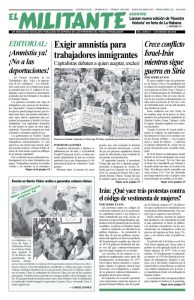U.S. prosecutors have not given up their witch hunt against the Bundy cattle-ranching family in Nevada, even after the feds’ frame-up charges against them and their supporters have either been thrown out of court or led to acquittal at trial.
The Nevada U.S. Attorney’s Office asked U.S. District Judge Gloria Navarro Feb. 7 to “reinstate the entire indictment” against Cliven Bundy, his sons Ammon and Ryan Bundy, and supporter Ryan Payne, or to allow them to prosecute on at least some of the charges.
At the same time the prosecutors moved that charges against four other defendants in a parallel case be dismissed, since, they admitted, there is little chance a conviction can be won.
When the frame-up began to unravel, Navarro decried the government’s “outrageous” and “flagrant misconduct” Jan. 8, and dismissed all the charges against the Bundys and Payne “with prejudice” — meaning they cannot be filed again. This is what government prosecutors are trying to get the judge to reverse.
The judge noted not only did the prosecution withhold evidence from the defendants, it made “several misrepresentations to the defense, and to the Court.” Among the “misrepresentations” — legalese for lies — were denials that the government deployed snipers and surveillance cameras around the Bundy ranch, as well as hiding the existence of government reports containing information that contradicted the prosecutions’ case against them.
The frame-up charges — from conspiracy to “impede and injure a federal officer” to “obstruction of justice” — stem from the refusal of Cliven Bundy to allow the Bureau of Land Management to confiscate hundreds of his cattle in April 2014. When the family called for help and hundreds of supporters showed up, federal agents backed down and the cattle were released.
The four defendants had been held in prison for some two years waiting for trial.
The BLM claimed that the restrictions on cattle grazing on federal land the Bundys had used for decades — restrictions that drove every other rancher in Clark County out of business — were necessary to protect the “threatened” desert tortoise. Yet in 2013 the U.S. Fish and Wildlife Service reported so many thousands of pet desert tortoises had been abandoned at a wildlife center that it couldn’t take any more.

